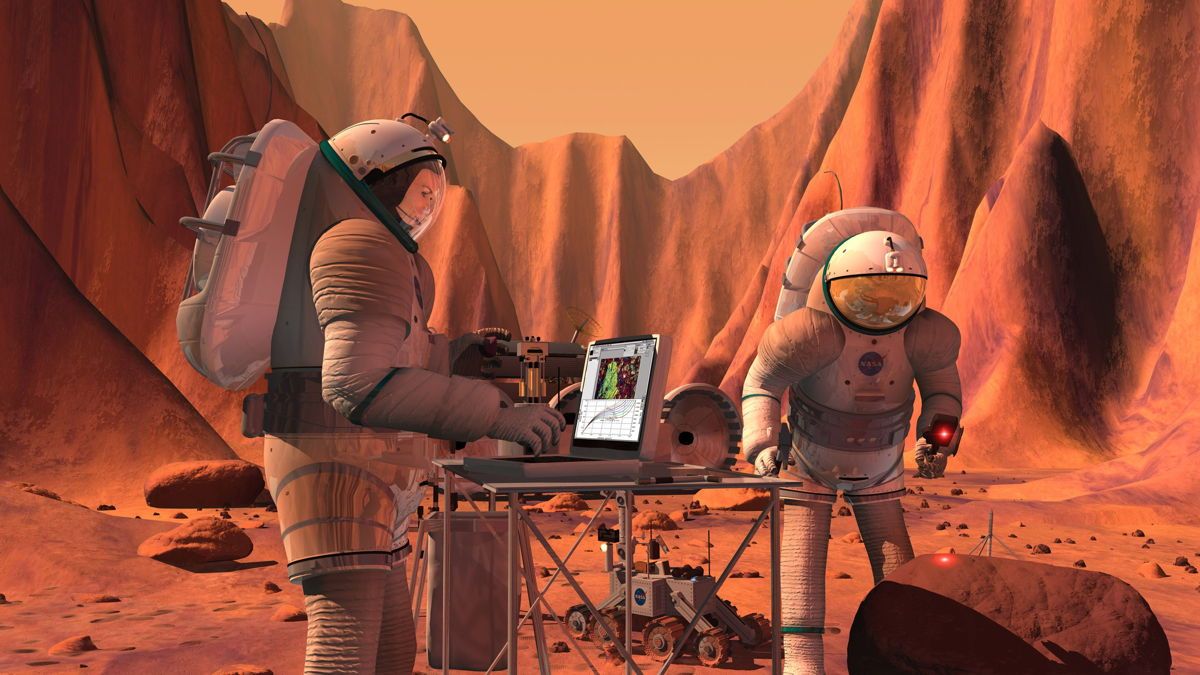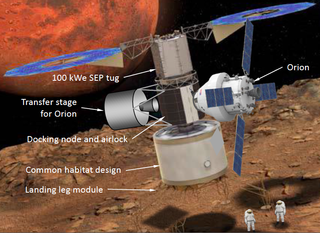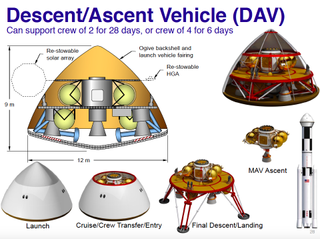
Putting boots on Mars by the end of the 2030s is not just a pipe dream, a new study suggests.
NASA could land astronauts on the Red Planet by 2039 without breaking the bank, provided the space agency takes a stepwise approach that includes a manned 2033 trip to the Mars moon Phobos, according to the research.
"Mars is possible, and in a time horizon of interest," Hoppy Price, of NASA's Jet Propulsion Laboratory in Pasadena, California, said May 20 during a presentation with the space agency's Future In-Space Operations (FISO) working group. "It could happen in our lifetime, and it wouldn't take a trillion dollars to do it." [5 Manned Mission to Mars Ideas]
Going through Phobos
Sending astronauts to Mars is the top long-term priority of NASA's human-spaceflight program. Indeed, President Barack Obama directed the agency to get people to the vicinity of the Red Planet by the mid-2030s.
"The vicinity" includes Mars orbit. And it's probably a good idea to get astronauts to orbit — specifically, to Phobos or Deimos, one of Mars' two tiny moons — before trying to land them on the dusty Martian surface, Price said. Breaking up a manned Red Planet campaign into two discrete parts dilutes the risks and costs, making them more manageable on a year-by-year basis, he explained.
So Price and two colleagues at the Jet Propulsion Laboratory (JPL) drew up a proposed mission architecture that gets astronauts to Phobosby 2033, then down to the surface of Mars by 2039. Their design is just a concept, not an official NASA strategy, Price stressed. But he hopes it helps people view manned Mars exploration in a more optimistic light.
"We've been hearing a lot in the last year about, 'It's so difficult to go to Mars; we'll never get there, we'll never get there in our lifetime. It costs a trillion dollars to go to Mars,'" Price said during the FISO presentation.
Sign up for the Live Science daily newsletter now
Get the world’s most fascinating discoveries delivered straight to your inbox.
"So we wanted to provide a very specific example of an architecture and a program that we could show that could plausibly be affordable and done within a time frame that, you know, most of us would still be alive to see," he added. [Moons of Mars: Photos of Phobos and Deimos]

How it would work
The plan, which was devised by Price, John Baker and Firouz Naderi, would establish a base on Phobos, a roughly 10-mile-wide (16 kilometers) moon that orbits 3,700 miles (6,000 km) from the Martian surface.
This effort would require four launches of NASA's Space Launch System (SLS) megarocket, which is currently in development and is scheduled to make its maiden flight in 2018.
The first Phobos-oriented SLS launch, in 2029, would loft a space tug and two chemical-propulsion payloads — a Phobos Transfer Stage and a Trans-Earth Injection Stage. The tug would use solar-electric propulsion (SEP) to haul the two payloads to Mars orbit in just less than four years. (The team's concept requires no big breakthroughs in propulsion technology or other areas, Price said.)
A second SLS liftoff would carry another SEP tug and the Phobos base, which could support a crew of four. The tug would take the base to Phobos and deposit it on the moon's surface, then stay with the habitat to provide power and move it to different locations on Phobos if desired.
The third SLS launch, around 2032, would carry a deep-space habitat (with the same basic design as the Phobos base) and a Mars Orbit Insertion Stage to Earth orbit. Another SLS liftoff would then send NASA's Orion capsule and a crew of four up to meet this preplaced gear, which would help take the astronauts to Mars orbit in a journey lasting 200 to 250 days.
The waiting Phobos Transfer Stage would ferry the astronauts down to the base in 2033, where the crew would remain for about 300 days. The astronauts would then head back to Earth; the Phobos habitat would remain on the Martian moon, awaiting possible use by future crews.
This Phobos campaign "would prove out the method for getting to Mars orbit and back," Price said.

Next stop: Mars
The architecture would use a similar multistep approach — employing SEP tugs to preposition equipment — to get astronauts to the Martian surface in 2039, but this second phase of the Red Planet effort would require six SLS launches, not four.
The JPL team's concept would send a 23-ton lander to Mars orbit, where it would await astronauts' arrival. This lander would include a habitat, as well as a Mars Ascent Vehicle that would get astronauts off the Red Planet and on their way back to Earth.
Unlike the robotic craft that NASA has sent to the Martian surface, this lander would touch down without the aid of parachutes. It would rely on retrorockets and, perhaps, a drag-increasing Supersonic Inflatable Aerodynamic Decelerator (SIAD), a prototype version of which the space agency plans to test in Hawaii this week for the second time. (The first test occurred in June 2014.)
This first manned surface stay would be a short one; the lander could support a crew of two for 28 days, or a crew of four for six days, Price said. But he envisions the historic mission as much more than just a "flags and footprints" endeavor, saying that it could pave the way for more ambitious follow-on efforts — for example, 12-month surface missions that launch every four years, eventually establishing a colony on the Red Planet.
"I think — eventually finding an in-situ water source on Mars — that we would want to, within 50 years or 100 years, evolve to a permanent presence — an Antarctica-type population on Mars," Price said. [Giant Leaps: Top Milestones of Human Spaceflight]
Would you move to Mars if you could?
How much would it cost?
Price and his team asked the nonprofit Aerospace Corporation to provide a cost estimate for this manned Mars architecture.
Price declined to divulge any dollar figures, but he did say that the team's proposed architecture — getting astronauts to Phobos in 2033 and to the Martian surface for a short stay in 2039 and a long stay in 2043 — was found to fit within NASA's annual budget, provided that the budget increases every year to adjust for inflation. (The Mars campaign would slightly exceed the agency's budget for a stretch in the mid-to-late 2020s, Price said; that bump would flatten out if the International Space Station ceased operations in 2024 as opposed to 2028, he added.)
"This is just aimed at showing an example that [manned] journeys could be doable using technologies NASA's pursuing, and on a time horizon of interest, without large spikes in the NASA budget," Price said.
The California-based Aerospace Corporation also did cost assessments for the U.S. National Research Council's 2014 report, "Pathways to Exploration: Rationales and Approaches for a U.S. Program of Human Space Exploration." (Congress ordered the NRC to perform the study back in 2010.)
The NRC report gives a rough estimate of how much it would cost to get astronauts to Mars. The effort is the equivalent of "perhaps 75-150 'flagship class' robotic exploration spacecraft (assuming an average cost of $1 to $2 billion each)," the authors wrote.
Follow Mike Wall on Twitter @michaeldwall and Google+. Follow us @Spacedotcom, Facebook or Google+. Originally published on Space.com.












